Update: SpaceX has released an official statement indicating that Starship Mk1’s November 20th failure came after a decision to intentionally pressurize the rocket prototype to its limits. This likely means that the test was to max flight pressures and not an intentional burst test, so Starship’s dome failure is still a significant concern and was definitely not planned.
More importantly, SpaceX says that it had already decided to retire Starship Mk1 before any kind of flight testing, treating the vehicle as a pathfinder. Instead, SpaceX will build and use Starship Mk3 – the next Boca Chica prototype – for Starship’s first attempted skydiver-style landing and 20 km (12 mi) flight test.
SpaceX statement on the above test and incident: pic.twitter.com/r1ReRYhUhz
— Michael Sheetz (@thesheetztweetz) November 21, 2019
SpaceX’s first full-scale Starship prototype has suffered a significant failure during testing, destroying or severely damaging large sections of the rocket. However, SpaceX CEO Elon Musk has already commented on the anomaly and is not all that concerned.
On November 20th, SpaceX – having canceled a planned road closure the day prior – unexpectedly requested a last-second road closure and entered into a much more serious round of testing with Starship Mk1, the rocket’s first full-scale prototype. This followed testing on November 18th that concluded with Starship Mk1’s very first ‘breath’ – some venting activity near the end of a tank proof test. SpaceX technicians spent the next 36 or so hours inspecting and working on Mk1, presumably looking for and patching minor leaks along its tank section.
The November 20th testing progressed far faster than the previous round of tests and Starship Mk1 was quickly venting again. Soon after that, frost began to appear on the exterior of its steel liquid oxygen and methane tanks, a telltale sign that some form of cryogenic testing was ongoing. Based on a distinct lack of activity at the nearby flare stack, SpaceX was using liquid oxygen (LOX) or liquid nitrogen (LN2) to verify that Starship performs as expected when filled with supercool propellant.
After initial venting and visible frost formation, SpaceX appeared to push forward, rapidly loading Starship Mk1 with LOX or LN2. This progress was easily visible thanks to the fact that the mass and pressure of all that cryogenic liquid made quick work of the slight imperfections on the exterior of Starship’s steel hull, turning the vehicle’s reflection from a speckled patchwork to an almost mirror-like finish. Roughly half an hour later, the otherwise peaceful scene was interrupted by the rapid failure of Starship Mk1’s upper LOX tank dome, instantly thrown several hundred feet into the air.
Seconds later, the crumpled upper half of Starship Mk1’s tank section appeared out of the clouds created and began hemorrhaging a huge volume of liquid oxygen, immediately boiling and vaporizing as it was exposed to the Earth’s comparatively white-hot atmosphere. Impressively, Starship appeared to remain functional after its top quite literally blew off, and the vehicle rapidly detanked and appeared to safe itself. Some ten minutes after the overpressure event, the freed liquid oxygen had boiled to nothing and Starship appeared to be quiet.
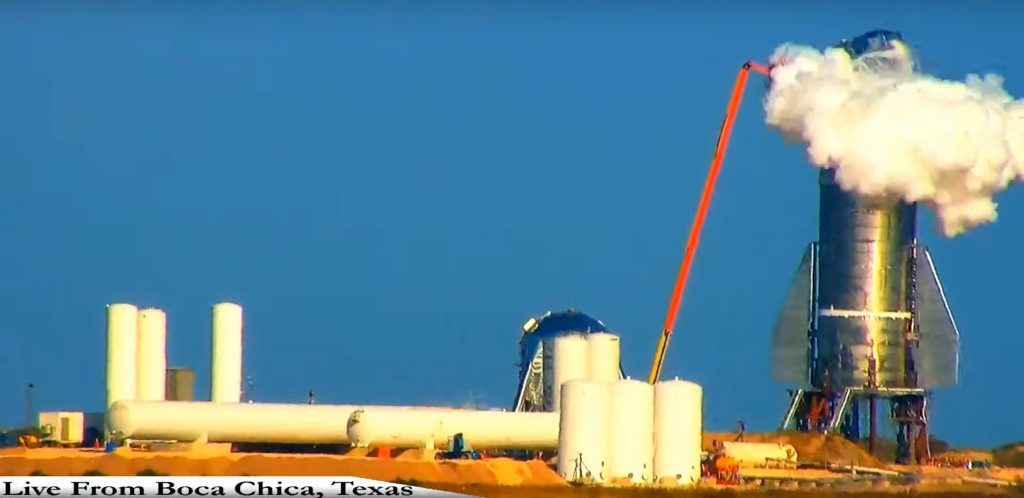
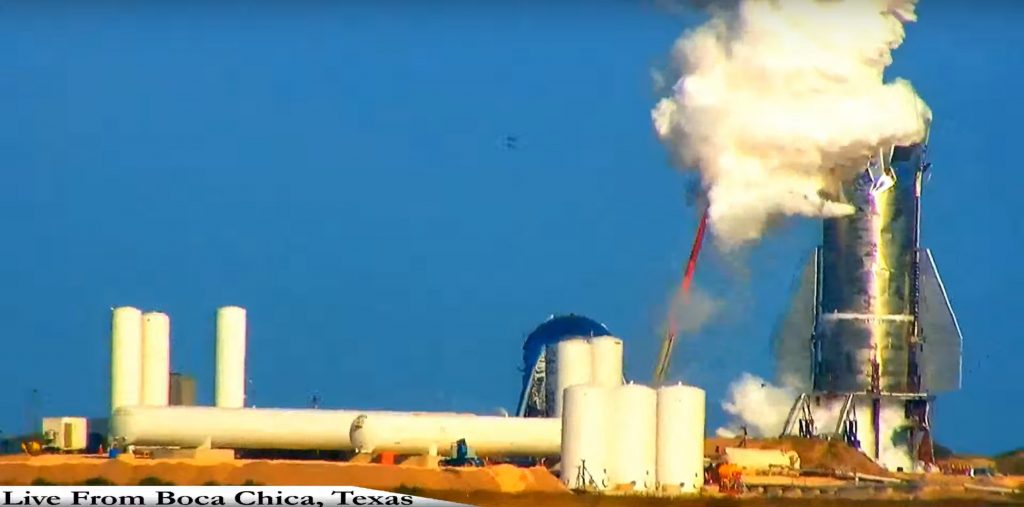
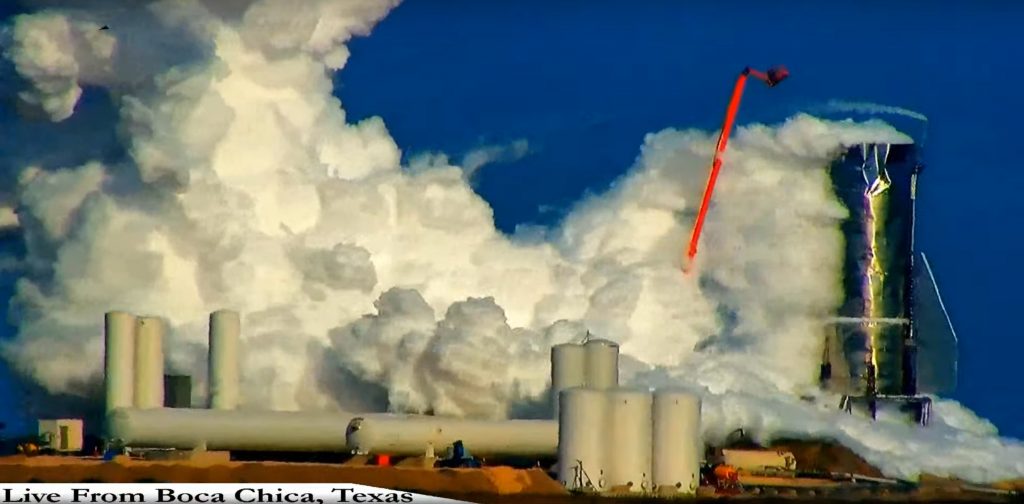
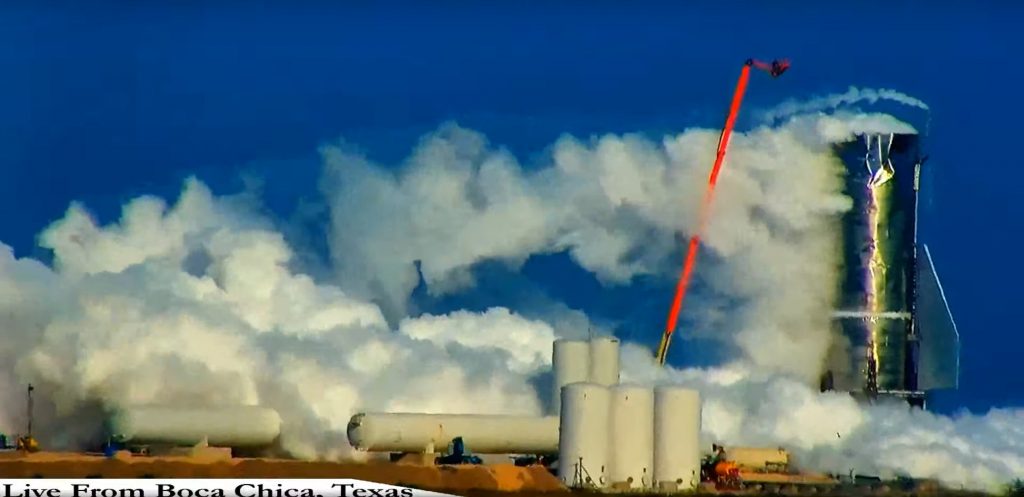
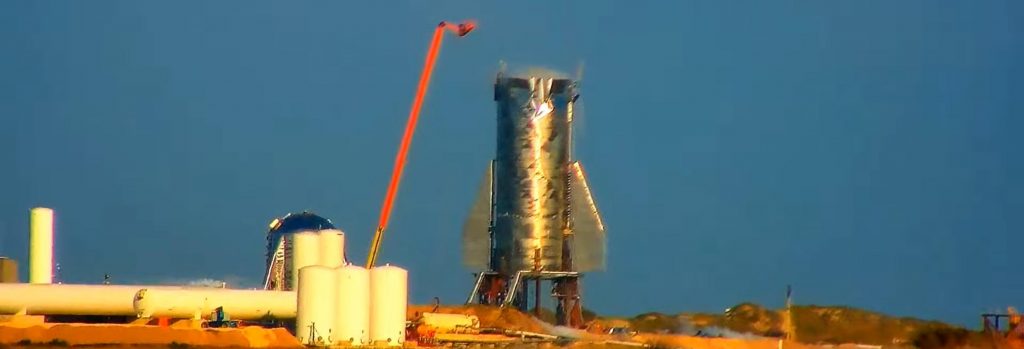
By all appearances, Starship Mk1 appeared to perform extremely well as an integrated system up to the point that its upper tank dome failed. The first frame from LabPadre’s stream with anything visibly amiss explicitly implicates the weld connecting the LOX dome to the cylindrical body of Starship’s LOX tank, point to a bad weld joint as the likeliest source of the failure. Although that hardware failure is unfortunate, Mk1’s loss will hopefully guide improvements in Starship’s design and manufacturing procedures.
Moving forward
Minutes after the anomaly was broadcast on several unofficial livestreams of SpaceX’s Boca Chica facilities, SpaceX CEO Elon Musk acknowledged Starship Mk1’s failure in a tweet, telegraphing a general lack of worry. Of note, Musk indicated that Mk1 was valuable mainly as a manufacturing pathfinder, entirely believable but also partially contradicting his September 2019 presentation, in which he pretty clearly stated that Mk1 would soon be launched to ~20 km to demonstrate Starship’s exotic new skydiver landing strategy.
Musk says that instead of repairing Starship Mk1, SpaceX’s Boca Chica team will move directly to Starship Mk3, a significantly more advanced design that has benefitted from the numerous lessons learned from building and flying Starhopper and fabricating Starship Mk1. The first Starship Mk3 ring appears to have already been prepared, but SpaceX’s South Texas focus has clearly been almost entirely on preparing Starship Mk1 for wet dress rehearsal, static fire, and flight tests. After today’s failure, it sounds like Mk1 will most likely be retired early and replaced as soon as possible by Mk3.
Above all else, the most important takeaway from today’s Starship Mk1 anomaly is that the vehicle was a very early prototype and SpaceX likely wants to have vehicle failures occur on the ground or in-flight. As long as no humans are at risk, pushing Starship to failure (or suffering unplanned failures like today’s) can only serve to benefit and improve the vehicle’s design, especially when the failed hardware can be recovered intact (ish) and carefully analyzed.
A step further, SpaceX is simultaneously building a second (and third) Starship prototype at its companion Cocoa, Florida facilities, and Starship Mk2 is nearly finished. Coincidentally, technicians installed its last tank dome – the same dome that failed on Mk1 – just days ago, and any insight that the Boca Chica team can gather from Mk1’s troubles will almost certainly be applied to Mk2, whether that means reinforcing its existing domes or fully replacing the upper dome with an improved design.
Check out Teslarati’s newsletters for prompt updates, on-the-ground perspectives, and unique glimpses of SpaceX’s rocket launch and recovery processes.

(adsbygoogle = window.adsbygoogle || []).push({});
<!–
–>
var disqus_shortname = «teslarati»;
var disqus_title = «SpaceX Starship blew its top during rocket fueling test (updated)»;
var disqus_url = «https://www.teslarati.com/spacex-ceo-elon-musk-next-steps-starship-failure/»;
var disqus_identifier = «teslarati-121018»;

